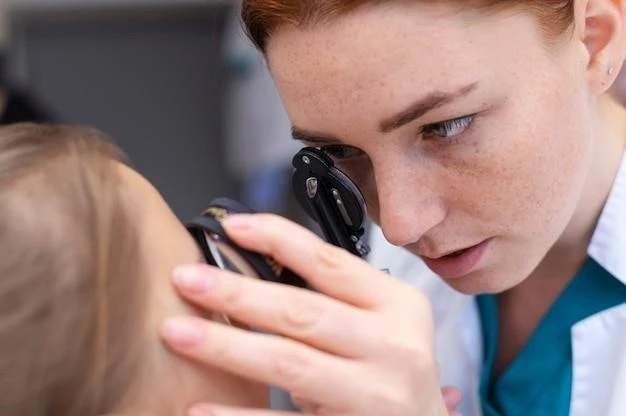Glaucoma‚ Congenital
Congenital glaucoma is a rare childhood disease that affects the eyes due to a genetic predisposition. It is characterized by increased intraocular pressure‚ potentially leading to vision loss. Early diagnosis and treatment are crucial to prevent optic nerve damage and visual impairment in children with this condition.
Introduction
Congenital glaucoma is a rare form of glaucoma that affects infants and young children. Unlike adult-onset glaucoma‚ which typically develops later in life‚ congenital glaucoma is present at birth or develops within the first few years of life.
This eye condition is often caused by abnormal development of the eye’s drainage system during fetal growth. The impaired drainage leads to a buildup of fluid in the eye‚ resulting in increased intraocular pressure.
Individuals with congenital glaucoma may have a hereditary predisposition to the condition‚ meaning it can run in families. While rare‚ this congenital disorder can have a significant impact on a child’s vision if not diagnosed and treated promptly.
Understanding the causes‚ symptoms‚ diagnosis‚ and treatment options for congenital glaucoma is essential to prevent permanent visual impairment in affected children. By exploring these aspects in detail‚ we can shed light on this hereditary condition and the challenges it poses for both patients and healthcare providers.
Understanding Glaucoma
Glaucoma is a group of eye conditions characterized by damage to the optic nerve‚ often due to high intraocular pressure. In the case of congenital glaucoma‚ this damage occurs early in life‚ affecting infants and young children.
The primary cause of glaucoma‚ including the congenital form‚ is usually improper drainage of the fluid (aqueous humor) within the eye. Normally‚ this fluid flows out through a mesh-like channel‚ maintaining the eye’s pressure. When this drainage system malfunctions‚ the fluid builds up‚ leading to elevated intraocular pressure.
The increased pressure inside the eye can cause damage to the optic nerve‚ which is vital for transmitting visual information to the brain. In congenital glaucoma‚ this optic nerve damage can manifest early in a child’s life and potentially result in permanent vision loss.
While intraocular pressure is a key factor in glaucoma‚ it’s important to note that not all cases of congenital glaucoma are solely due to high pressure. Other factors‚ such as genetic predisposition and abnormalities in the eye’s development‚ also play significant roles in the onset and progression of this condition.
Understanding the mechanisms of glaucoma‚ including congenital glaucoma‚ is crucial for early detection and intervention to preserve a child’s vision and prevent long-term visual impairment. By grasping the underlying factors contributing to this condition‚ healthcare professionals can implement appropriate management strategies for affected individuals.
Causes and Risk Factors
Congenital glaucoma‚ a rare childhood disease‚ has various causes and risk factors contributing to its development. The condition is primarily linked to abnormalities in the eye’s drainage system‚ leading to increased intraocular pressure.
One of the main causes of congenital glaucoma is a genetic predisposition. Children born to parents with a history of glaucoma or carrying specific genetic mutations may have an increased risk of developing this condition. Inherited genetic factors can play a significant role in the early onset of glaucoma in infants.
Abnormalities in the development of the eye structures can also contribute to congenital glaucoma. During fetal growth‚ if the drainage angle or outflow pathways in the eye do not form correctly‚ it can result in fluid buildup and elevated intraocular pressure after birth.
Certain medical conditions or infections during pregnancy can be associated with an increased risk of congenital glaucoma in the child. Maternal health factors‚ such as gestational diabetes or exposure to certain medications‚ may influence the development of the infant’s eyes and contribute to the onset of the condition.
While congenital glaucoma can occur sporadically‚ without a familial history‚ the combination of genetic predisposition and developmental abnormalities significantly raises the likelihood of this eye disorder. Understanding the interplay of these causes and risk factors is crucial for early identification and management of congenital glaucoma in affected children.
Symptoms and Diagnosis
Congenital glaucoma presents specific symptoms and requires early diagnosis to prevent vision loss. Infants and young children with this condition may exhibit signs that differ from adult-onset glaucoma.
Some common symptoms of congenital glaucoma include photophobia (sensitivity to light)‚ excessive tearing‚ and enlargement of the eye (buphthalmos). Parents may notice cloudiness in the cornea‚ as well as the child’s reluctance to open or rub their eyes due to discomfort.
Diagnosing congenital glaucoma involves a comprehensive eye examination by a pediatric ophthalmologist. The evaluation may include measuring intraocular pressure‚ assessing the size and shape of the eye‚ and examining the optic nerve for signs of damage.
In some cases‚ imaging tests like ultrasound or gonioscopy may be used to visualize the eye structures and determine the extent of fluid buildup. Additionally‚ genetic testing may be recommended for children with a family history of glaucoma to identify specific gene mutations associated with the condition.
Early detection of congenital glaucoma is critical for preserving vision and preventing optic nerve damage. Regular eye screenings for infants and young children‚ especially those with a known risk of hereditary eye conditions‚ can aid in the prompt identification and management of this congenital disorder.
Effects on Vision
Congenital glaucoma can have profound effects on a child’s vision if left untreated. The condition primarily impacts the optic nerve‚ which is responsible for transmitting visual information from the eye to the brain.
Elevated intraocular pressure in congenital glaucoma can lead to optic nerve damage over time. This damage can result in irreversible vision loss‚ affecting the child’s ability to see clearly and perceive the world around them.
Children with congenital glaucoma may experience a gradual decline in visual acuity due to the progressive deterioration of the optic nerve. As the condition advances‚ peripheral vision loss may occur‚ impacting activities that require spatial awareness and peripheral sight.
In severe cases of congenital glaucoma where treatment is delayed or inadequate‚ the damage to the optic nerve can be extensive‚ leading to complete vision impairment in the affected eye. This loss of vision can significantly impact a child’s development and quality of life.
Early intervention and proper management of congenital glaucoma are crucial in preserving the child’s vision and preventing long-term visual impairment. By addressing the elevated intraocular pressure and protecting the optic nerve‚ healthcare providers aim to mitigate the negative effects of the condition on the child’s eyesight.
Treatment Options
The management of congenital glaucoma focuses on reducing intraocular pressure and preserving the child’s vision. Treatment options may vary depending on the severity of the condition and the child’s overall health.
One of the primary treatment approaches for congenital glaucoma is the use of medicated eye drops to lower intraocular pressure. These eye drops aim to regulate the fluid flow within the eye and decrease the pressure on the optic nerve‚ helping to preserve vision.
In cases where eye drops alone are insufficient to control intraocular pressure‚ surgical intervention may be necessary. Surgical procedures for congenital glaucoma typically involve creating a new drainage pathway for the excess fluid to alleviate pressure buildup.
Common surgical techniques for congenital glaucoma include trabeculotomy‚ trabeculectomy‚ and goniotomy‚ which aim to improve the outflow of fluid from the eye and reduce intraocular pressure. These procedures are often performed by experienced ophthalmic surgeons specialized in pediatric eye care.
Regular monitoring and follow-up appointments are essential in the long-term management of congenital glaucoma. Healthcare providers will continually assess the child’s intraocular pressure‚ optic nerve health‚ and overall vision to ensure treatment efficacy and adjust the management plan as needed;
By combining medical therapy‚ surgical interventions‚ and ongoing monitoring‚ healthcare professionals can provide comprehensive care for children with congenital glaucoma. The goal of treatment is to maintain optimal intraocular pressure‚ protect the optic nerve‚ and safeguard the child’s visual function for improved quality of life.
Living with Congenital Glaucoma
Living with congenital glaucoma presents unique challenges for children and their families‚ requiring ongoing support and management strategies to optimize vision and quality of life. Coping with the effects of this hereditary condition involves a multidisciplinary approach that addresses both the medical and psychosocial aspects of the disease.
Education and awareness play a crucial role in empowering children with congenital glaucoma to understand their condition and participate in their care. Parents and caregivers often work closely with healthcare providers to ensure consistent treatment adherence and regular eye examinations to monitor disease progression.
Children with congenital glaucoma may benefit from vision rehabilitation services and support groups tailored to their specific needs. These resources can offer practical tools to enhance visual skills‚ adapt to changes in vision‚ and connect with peers facing similar challenges.
Promoting independence and self-esteem in children with congenital glaucoma is essential for their emotional well-being and development. Encouraging open communication about the condition‚ providing opportunities for social interaction‚ and fostering a positive self-image can help children navigate the daily impact of glaucoma on their lives.
As children with congenital glaucoma transition into adolescence and adulthood‚ ongoing eye care and vision monitoring remain essential components of their long-term health management. Regular follow-up visits with ophthalmologists specialized in pediatric glaucoma are vital to address any changes in intraocular pressure and optic nerve health.

By creating a supportive environment that addresses the physical and emotional aspects of living with congenital glaucoma‚ children affected by this condition can lead fulfilling lives and achieve their full potential despite the challenges posed by this hereditary eye disorder.
